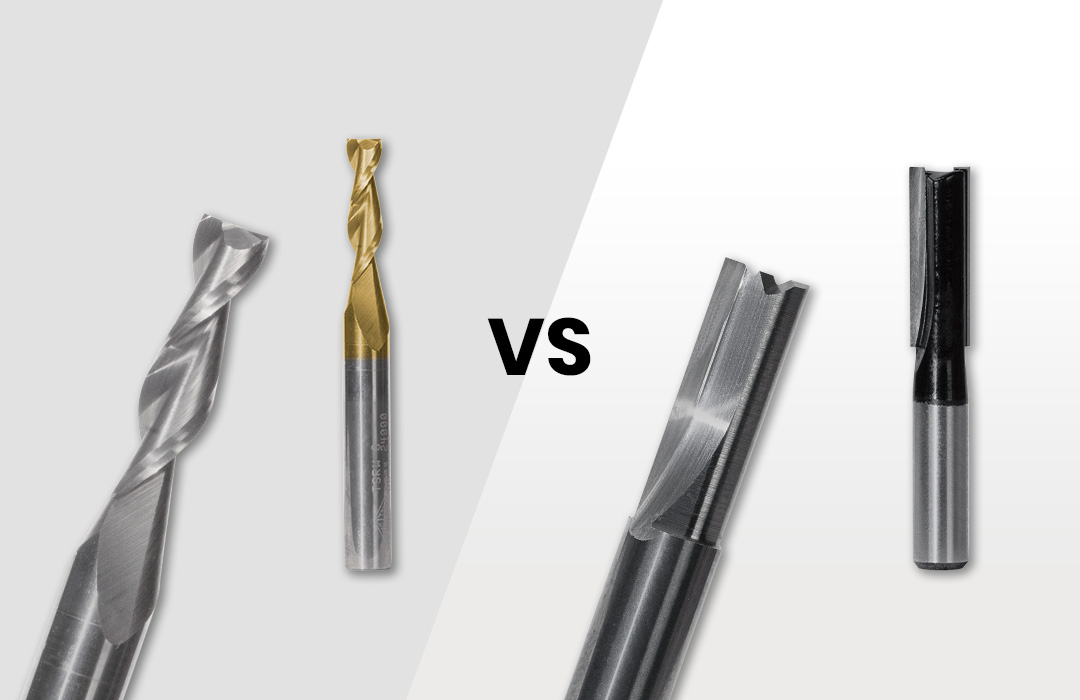Spiral Bits Vs Straight Bits
29.11.2021

Often router operators using straight fluted router bits ask — should I upgrade to spiral flute cutters?
You might find yourself wondering if it is in fact an upgrade. That’s why we are here to answer all your spiral bit questions. When it comes to choosing the correct bit it can often be a question of whether a straight bit is up to the task of performing adequately in the material being machined. If you’re cutting a particular material and notice a rough finish — it might be a sign that a straight bit is unsuitable.
Achieving A Clean Finish
Left with a rough finish? It might be time to check your tools.
Start by inspecting the state of the cutting edge to determine if it needs sharpening. You can complete a visual inspection, coupled with carefully running your fingernail gently along the cutting edge to detect if the cutter is dull by identifying micro-chips or edge fracture. Just make sure you use extreme care to avoid cutting your finger. The edge might feel dull or blunt. It may even show signs of burning. This will be evidenced by dark markings ranging from very slight to visible caked up burnt material on the cutter and is normally due to too slow a feed rate during operation. i.e. Too much rubbing & not enough cutting has occurred. You can correct this by increasing the feed rate.
Materials containing glues or adhesives are more prone to burning than natural timbers. Having your cutter serviced by a professional sharpening shop or changing to a sharper cutter might be all that’s needed.
How do you proceed when you’ve tried your sharpest straight bit, experimented by varying the feed rate and, if your router is equipped with a variable speed adjustment, you’ve altered the spindle speed. You’ve also checked the setup, ensuring all fences, guides and associated machine components are all rigid and everything is adjusted and tightened correctly in the quest to achieve the desired finish, but your material is still proving difficult to cut satisfactorily? Then it might be time to try out a spiral flute cutter.
The Benefits of a Spiral Cutter
There are several distinct advantages that spiral bits offer over straights.
The ‘shear angle’ provided by a spiral flute will apply pressure to the timber face or surface while cutting which can potentially solve your edge finish problems. The spiral imparts a ‘slicing’ action when compared to the ‘chopping’ action predominant with that of a straight bit.
The direction of the spiral will determine the direction of the chip flow so you have the option of pulling the swarf upwards and out of the job or pushing the chips downward and gaining some workholding stability.
Spiral Bits Advantages
They effectively present more cutting edge to the workpiece. For example — a straight bit with a 50mm cutting length has literally that. By contrast, a spiral with a 50mm cutting length may in fact have 75mm of cutting edge because the flute “wraps around the shank.” The workload is shared over a longer section of cutting edge.
This also provides a greater length of cut over which to dissipate the heat generated from cutting. The resultant cooler operating temperatures can prove to be a significant advantage, offering longer tool life and less chance of burning. Spirals are routinely used on materials like nonferrous metals such as brass or copper and especially aluminium. Improved surface finish can often be achieved with spirals on various materials and some composite materials will necessitate the use of spirals to attain an adequate result.
There seems to be a constant flow of new composite materials into the market and the advanced tool geometry of spiral flute cutters is more frequently the only suitable option. This is often where a spiral cutter comes into its own. Advanced high performance coatings, available as standard, enhance a spiral flute cutter’s capacity to effectively machine difficult composites.
Have we got you excited to try out a spiral bit for your next project? Take a look at our range of router bits to ensure that you achieve the perfect finish every time.
Need a helping hand? Contact Carbitool for expert advice from the woodworking masters.
